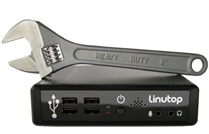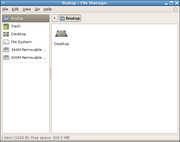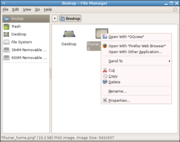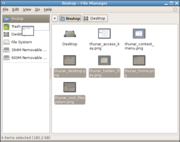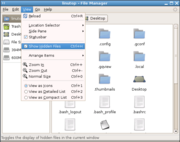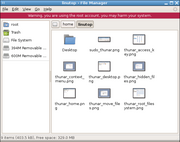Tutorials/Files
From LinutopWiki
Contents |
Browsing your files on the Linutop
If you're used to Microsoft Windows sytems, you might be surprised by the file organisation on the Linutop OS.
Standard use
First a bit of theory. The root of the filesystem is represented by a '/' (slash), and is called the root directory. Every file on the computer will have an absolute path based on '/'. For instance, '/usr/' is a directory that you can find on the root filesystem. '/usr/bin/' is another directory, included in '/usr', and finally '/usr/bin/Thunar' is a file that you can find in the '/usr/bin/' directory.
Forget about c:, d:, etc, they don't exist on Linux. Instead, each device (USB key, hard disk...) is mounted in the filesystem. This means that the files existing on the device will be included in the filesystem hierarchy, and the user will not have to know if he is accessing the hard disk or an over device although it is possible to know, of course. For instance, the Linutop system (on the USB key) is mounted on '/cdrom', so if you want to modify a file stored on the USB key, you'll find this file in /cdrom.
Every user is the owner of what is called a home directory. This is a place where he will be allowed to do anything he wants. On the linutop this directory (for the default 'linutop' user) is '/home/linutop'. You can browse this directory by double-clicking the 'Documents' icon on the desktop (this will run the software Thunar). The image on the left show the contents of your home directory. On the left pane you can see several shortcuts: your home directory, your trash, your desktop, the root filesystem, and shortcuts to the USB key on which the system runs. Clicking on each shortcut will display the contents of the selected location.
Actions are associated to files, depending on their type. A right click on the file will pop a menu, in which you'll be able to select the action you want to do with your file. Double-clicking on the file will execute the default action. You can select several files at the same time to perform an action. This works exactly as with Windows, click and hold the button, move the mouse and release the button; you can use the ctrl and shift keys as well.
OS version
To find out what version of linutop OS you have, simply open the file '/proc/version'. It may look something like this:
Linux version 2.6.23.9-linutop-2 (root@zero) (gcc version 4.1.2 20060928 (prerelease) (Ubuntu 4.1.1-13ubuntu5)) #1 PREEMPT Wed Feb 27 09:33:35 UTC 2008
Advanced features
Hidden files
On linux systems, every file whose name starts with a dot is 'hidden'. Thus, thunar doesn't show these files by default. In the home directory, hidden files are usually configuration file that users don't need to see. But it is possible to display them. You just need to active the Show hidden files in the View menu of thunar.
Root access
A standard user can only modify files in his own home directory. To access the other files of the system, he needs super user permissions. The super user is also called root, and has access to every file of the system. If you want to access the files on the system USB key, you'll have to become root (the default linutop user linutop can become root). To run thunar with root permissions:
- type alt+f2
- enter "gksudo thunar" in the dialog then press enter
Thunar is now in root mode. Be careful! You can damage the system (at least for the current session, but you can reboot and/or use the restoration system).
